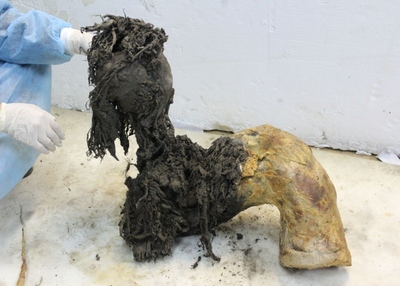World's oldest known RNA extracted from woolly mammoth

In a significant milestone, researchers have succeeded in isolating and sequencing RNA molecules from woolly mammoths dating back to the Ice Age. These RNA sequences are understood to be the oldest ever recovered, coming from mammoth tissue preserved in the Siberian permafrost for nearly 40,000 years.
The team’s study, published in the journal Cell, shows that not only DNA and proteins, but also RNA, can be preserved for very long periods of time, and provide new insights into the biology of species that have long since become extinct. The work was carried out at both Stockholm University and the University of Copenhagen, and is a collaboration between SciLifeLab and the Centre for Palaeogenetics — a joint initiative between Stockholm University and the Swedish Museum of Natural History.
“With RNA, we can obtain direct evidence of which genes are ‘turned on’, offering a glimpse into the final moments of life of a mammoth that walked the Earth during the last Ice Age,” said lead author Emilio Mármol, formerly a postdoctoral researcher at Stockholm University and now based at Copenhagen’s Globe Institute.
“This is information that cannot be obtained from DNA alone.”
Sequencing prehistoric genes and studying how they are activated is important to understand the biology and evolution of extinct species. For years, scientists have been decoding mammoth DNA to piece together their genomes and evolutionary history. But RNA — the molecule that reveals which genes are active — has until now remained out of reach, as the long-held belief that RNA is too fragile to even survive a few hours after death has likely discouraged researchers from exploring these information-rich molecules in mammoths and other long-extinct species.
“We have previously pushed the limits of DNA recovery past a million years; now, we wanted to explore whether we could expand RNA sequencing further back in time than done in previous studies,” said Love Dalén, Professor of Evolutionary Genomics at Stockholm University and the Centre for Palaeogenetics.
“We gained access to exceptionally well-preserved mammoth tissues unearthed from the Siberian permafrost, which we hoped would still contain RNA molecules frozen in time,” Mármol added.
The researchers were able to identify tissue-specific patterns of gene expression in frozen muscle remains from Yuka, a juvenile mammoth that died almost 40,000 years ago. Among the more than 20,000 protein-coding genes in the mammoth’s genome, far from all of them were active. The detected RNA molecules code for proteins with key functions in muscle contraction and metabolic regulation under stress.

“We found signs of cell stress, which is perhaps not surprising since previous research suggested that Yuka was attacked by cave lions shortly before his death,” Mármol said. The researchers also found a myriad of RNA molecules that regulate the activity of genes in the mammoth muscle samples.
“RNAs that do not encode for proteins, such as microRNAs, were among the most exciting findings we got,” said Marc Friedländer, Associate Professor at the Department of Molecular Biosciences, The Wenner-Gren Institute at Stockholm University and SciLifeLab.
“The muscle-specific microRNAs we found in mammoth tissues are direct evidence of gene regulation happening in real time in ancient times. It is the first time something like this has been achieved.”
The microRNAs that were identified also helped the researchers confirm that the findings really came from mammoths.
“We found rare mutations in certain microRNAs that provided a smoking-gun demonstration of their mammoth origin,” noted Bastian Fromm, Associate Professor at The Arctic University Museum of Norway. “We even detected novel genes solely based on RNA evidence, something never before attempted in such ancient remains.”
According to Dalen, the results demonstrate that RNA molecules can survive much longer than previously thought.
“This means that we will not only be able to study which genes are ‘turned on’ in different extinct animals, but it will also be possible to sequence RNA viruses, such as influenza and coronaviruses, preserved in Ice Age remains,” he said. In the future, the researchers hope to conduct studies that combine prehistoric RNA with DNA, proteins and other preserved biomolecules.
“Such studies could fundamentally reshape our understanding of extinct megafauna as well as other species, revealing the many hidden layers of biology that have remained frozen in time until now,” Mármol concluded.
Mini lung organoids could help test new treatments
Scientists have developed a simple method for automated the manufacturing of lung organoids...
Clogged 'drains' in the brain an early sign of Alzheimer’s
'Drains' in the brain, responsible for clearing toxic waste in the organ, tend to get...
The voice of reason: natural language interfaces to transform lab informatics
In everyday life, voice interaction with technology can save time and reduce friction. The same...





